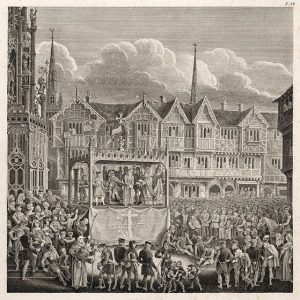By Donato Cabrera│medium.com/@donatocabrera
December 11, 2020

“Representation of a Pageant Vehicle at the time of Performance,” by David Gee (1825)
While some songs have the luck to remain on the charts for a few months, there are songs that have remained in humanity’s conscience for centuries. Coventry Carol is one of them.
The earliest example of the text of the carol is found in a mystery play called The Pageant of the Shearmen and Tailors, first written down in 1534. The carol refers to the moment in the Christmas story, as told in the Gospel of Matthew, of the Massacre of the Innocents, when King Herod orders the murder of all male infants under the age of two in Bethlehem. In the play the text is sung as a lullaby by the mothers of the children who will be killed.
Lully, lullah, thou little tiny child,
Bye bye, lully, lullay.
Thou little tiny child,
Bye bye, lully, lullay.O sisters too, how may we do
For to preserve this day
This poor youngling for whom we sing,
“Bye bye, lully, lullay”?Herod the king, in his raging,
Chargèd he hath this day
His men of might in his own sight
All young children to slay.That woe is me, poor child, for thee
And ever mourn and may
For thy parting neither say nor sing,
“Bye bye, lully, lullay.”
The melody was first written down in 1591 but, like the text, it is of unknown origin. In its original form, which is for three parts, there is an incredibly dissonant moment that was removed and glossed over and the versions we know now sound like this.
As beautiful as this version is, the pungency of that “wrong” note is missing. For me, that dissonance is the pain that that mothers are feeling as they sing this lullaby to their children, knowing that they will soon be murdered. Here is a great recording of that original carol from so long ago. For those of you who want to know the exact moment of the dissonance, it first happens 30 seconds in.
